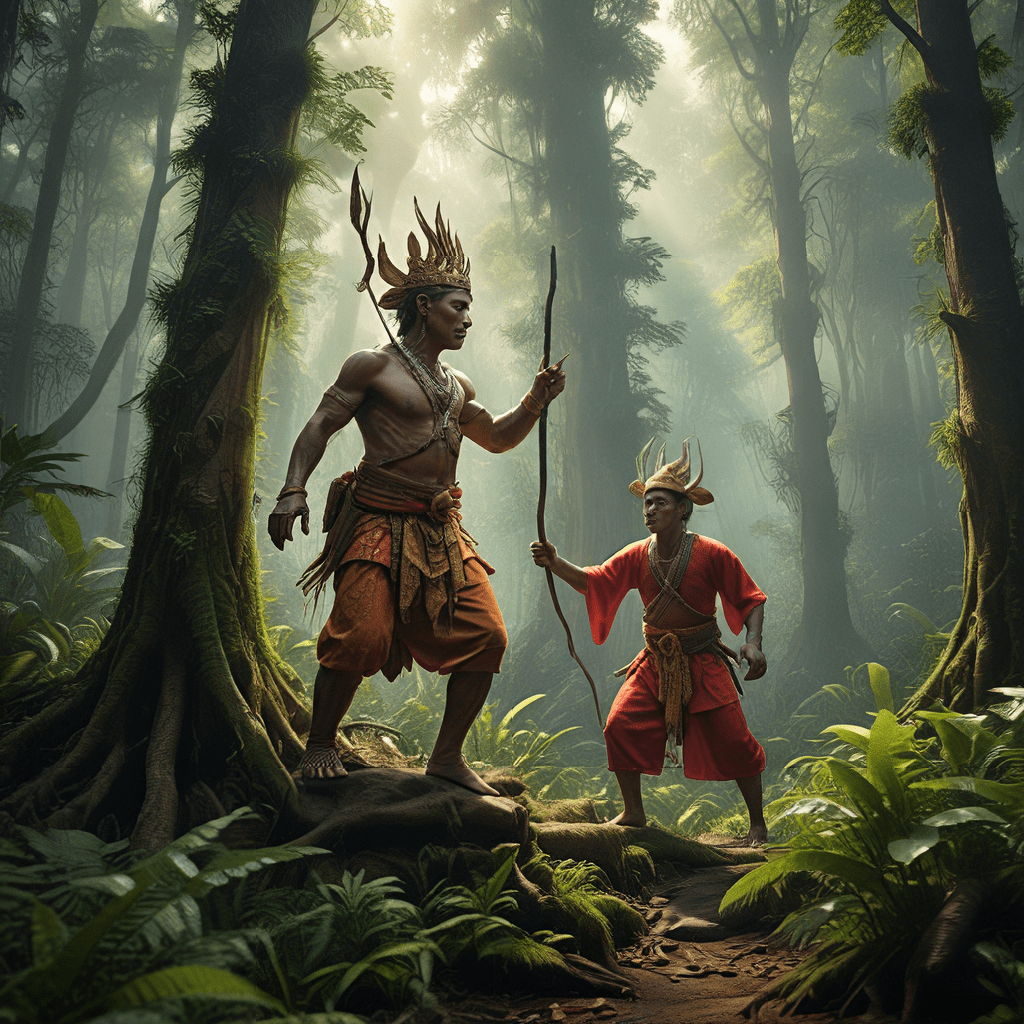Indonesian Folklore: Secrets of the Mythical Forests
The Spirit World Within: Forests in Indonesian Folklore
The forests of Indonesia, a vast archipelago teeming with life, are more than just trees and foliage. They are living, breathing entities infused with spirit and myth, a realm where the unseen world intersects with the human experience. In Indonesian folklore, the forests are not simply landscapes, but tapestries woven with ancient stories, vibrant spirits, and potent magic. They are places of both wonder and danger, where the boundaries between the physical and the mystical blur.
These mythical forests are woven into the very fabric of Indonesian culture. Their stories, passed down through generations, offer a window into the beliefs and values of the people. They speak of a deep respect for nature and its powerful forces, a reverence for the spirits that inhabit the natural world, and a keen awareness of the interconnectedness between humans and the environment.
Guardians of the Green: Forest Spirits and Deities
Within the Indonesian forest, a rich tapestry of spirits and deities watch over the trees and creatures. These beings, often anthropomorphic or animalistic, embody the power and mystery of the natural world. They can be benevolent guardians, offering protection and guidance to those who respect them, or fearsome protectors, unleashing their wrath on those who transgress their boundaries.
Among the most prominent forest spirits are the hantu (ghosts), often associated with death and misfortune. They are believed to inhabit isolated places within the forest, and encountering them is considered a bad omen. The spirits of the forest, known as dewa (gods) or dewi (goddesses), are more powerful and benevolent. They often symbolize specific aspects of nature, such as Dewi Sri, the goddess of rice and agriculture, or Sang Hyang Tunggal, the ultimate deity associated with creation and the cosmic order.
Sacred Groves and Taboo Territories: The Power of the Forbidden
Certain areas within the Indonesian forest are considered sacred, imbued with a powerful spiritual energy. These sacred groves, often marked by ancient trees or natural formations, are places where spirits dwell and where humans must tread cautiously. Entering these areas without respect can invite misfortune or even the wrath of the spirits.
Taboos are a vital part of Indonesian forest folklore. They represent rules and restrictions imposed by the spirits or by ancestors, meant to protect the sanctity of the forest and ensure its continued well-being. These taboos can range from prohibitions against hunting certain animals to restrictions on cutting down specific trees. Violating these taboos is believed to bring misfortune and imbalance to the ecosystem.
The Forest as a Source of Life and Sustenance: A Symbiotic Relationship
For generations, the people of Indonesia have relied on the forest for their survival. It provided food, shelter, medicine, and materials for tools and clothing. This intimate connection between humans and the forest fostered a deep respect for the natural world and its resources.
The forest is not simply a source of material wealth, but a place of spiritual nourishment and connection. Its bounty is seen as a gift from the spirits, to be used with gratitude and respect. Indonesian folklore often depicts the forest as a source of wisdom, healing, and spiritual growth.
The Forest as a Realm of Transformation: Trials, Initiation, and Spiritual Growth
Many Indonesian myths and legends feature journeys into the forest, often as trials or initiations. These voyages into the heart of the wilderness represent a transformation, a passage from childhood to adulthood, or a journey toward enlightenment. The hero or heroine encounters challenges, faces their fears, and ultimately emerges transformed, having learned valuable lessons about life and the natural world.
The forest is seen as a place of both danger and opportunity, where individuals can test their limits and discover their true potential. Through their experiences in the forest, they learn to navigate the complexities of the human condition and to find their place in the larger web of life.
The Forest as a Source of Magic and Mysticism: Herbalism, Spells, and Rituals
The Indonesian forest is a treasure trove of potent herbs and plants, each believed to possess unique medicinal and magical properties. This belief in the healing and transformative power of nature is deeply ingrained in Indonesian folklore. Traditional healers, known as dukun, use their knowledge of herbs and rituals to treat illnesses and to bring about desired outcomes.
The forest is seen as a source of potent energy, a place where spirits and humans can interact through rituals and offerings. These practices, often involving prayers, chants, and the use of sacred objects, are believed to appease the spirits, harness their power, and bring about favorable results. The forest is not just a source of physical sustenance but also a source of spiritual power, offering the potential for healing, protection, and guidance.
The Influence of Animism and Shamanism: Respect for Nature’s Spirits
Animism, the belief that all things in nature possess a spirit or soul, is a fundamental element of Indonesian folklore. This worldview emphasizes the interconnectedness of all living things and fosters a deep respect for the natural world. The forests, with their diverse flora and fauna, are seen as vibrant ecosystems teeming with spirits, each possessing its own unique power and personality.
Shamanism, a spiritual practice that involves communication with the spirit world, also plays a significant role in Indonesian folklore. Shamans, known as dukun, are believed to possess the ability to traverse the realms of the living and the dead, to communicate with spirits, and to access the knowledge and power of the natural world. Their role is to maintain balance within the ecosystem, to heal the sick, and to protect communities from harm.
Myths of Origin and Creation: The Forest as a Cradle of Civilization
Indonesian myths of origin often feature the forest as the birthplace of humanity and the cradle of civilization. These stories recount how the first humans emerged from the forest, learning to live in harmony with nature and to cultivate the land. They represent the enduring bond between humans and the forest, a connection that has shaped Indonesian culture and traditions for centuries.
These creation myths often depict the forest as a place of immense power and wisdom, a source of knowledge that guides humans on their journey through life. They emphasize the importance of respecting the forest and its spirits, understanding that humans are part of a larger web of life.
The Forest in Modern Indonesian Culture: Contemporary Perspectives
Despite the rapid pace of modernization, the mythical forests of Indonesia continue to hold a powerful place in the hearts and minds of the people. While urbanization and development have brought changes to the relationship between humans and the natural world, the stories and beliefs associated with the forest remain deeply ingrained in Indonesian culture.
Contemporary artists, writers, and musicians draw inspiration from the myths and legends of the forest. These creative expressions serve as reminders of the enduring power of ancient traditions and the importance of preserving the cultural heritage of Indonesia. Moreover, the growing awareness of environmental issues has led to a renewed interest in the ecological and spiritual significance of the forest.
The Preservation of Folklore: Protecting the Myths and Stories of the Forest
The preservation of Indonesian folklore is essential for ensuring the continuity of cultural identity and for promoting respect for the natural world. Through oral traditions, storytelling, and the documentation of myths and legends, the stories of the mythical forests are passed down from generation to generation.
Organizations, scholars, and community groups work tirelessly to preserve and share the rich tapestry of Indonesian folklore. This effort is crucial not only for maintaining cultural heritage but also for fostering a deeper understanding of the complex relationship between humans and the environment. By celebrating and protecting the myths and stories of the forest, we can ensure that future generations will continue to appreciate the profound connection between culture, nature, and the spirit world.
FAQ
What are some of the most common forest spirits in Indonesian folklore?
Some of the most common forest spirits in Indonesian folklore include the hantu (ghosts), dewa (gods), and dewi (goddesses). Each of these spirits has its own unique characteristics and powers, and they often represent specific aspects of nature, such as death, protection, or fertility.
What are some examples of sacred groves in Indonesian folklore?
Sacred groves are often found in areas with ancient trees, natural formations, or other significant landmarks. They are considered sacred spaces where spirits dwell and where humans must tread cautiously. Examples include the Alas Purwo forest in East Java and the Uluwatu temple in Bali, both of which are believed to be inhabited by powerful spirits.
How does Indonesian folklore reflect a respect for nature?
Indonesian folklore reflects a deep respect for nature by emphasizing the interconnectedness of all living things and the importance of maintaining balance within the ecosystem. The stories often depict the forest as a living entity with its own spirits and rules, and they warn against disrespecting or harming the natural world.
How is the forest portrayed as a source of transformation in Indonesian folklore?
The forest is often portrayed as a place of trials and initiations, where individuals can face their fears, learn valuable lessons, and emerge transformed. Many myths and legends involve heroes or heroines who journey into the forest, overcoming challenges and returning with new knowledge and understanding.
What are some ways that Indonesian folklore is being preserved in modern times?
Indonesian folklore is being preserved through a variety of means, including the continued practice of oral storytelling, the documentation and publication of myths and legends, and the creation of art, music, and literature inspired by traditional folklore. Schools, community groups, and cultural institutions are also playing an active role in promoting and preserving the rich tapestry of Indonesian folklore.


